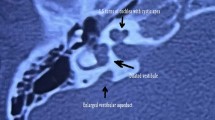Abstract
The aim of this study was to investigate speech and language development after long-term cochlear implantation in children with bony labyrinth malformations (BLMs) and to present the surgical findings in this group of patients. The auditory and linguistic skills of 21 children who had BLM were assessed in this study. They were implanted between 1998 and 2009. Twenty-two sex-matched and age-matched implantees without BLM were evaluated as the control group. To compare speech perception and speech intelligibility between the groups, the categories of auditory performance (CAP) test and speech intelligibility rating (SIR) test, respectively, were administered. The Turkish version of the Test of Early Language Development (TELD-3-T) was administered to evaluate and compare the linguistic skills of the groups. Surgical findings and complications were also analyzed. Implanted anomalies were common cavity in five patients, incomplete partition type 1 in 5 patients, and incomplete partition type 2 in 11 patients. The CAP and SIR scores were significantly higher in the control group (p < 0.05), but the TELD-3-T test scores were comparable among the groups (p > 0.05). Based on the specific type of malformation, the CAP and SIR scores were comparable between the subgroups (p > 0.05). No perioperative complications occurred in the control group. However, various perioperative complications (gusher, etc.) and surgical difficulty occurred in the anomaly group. The malformation group had unsatisfactory results with regard to speech perception skills; however, this group and the non-anomalous group exhibited comparable long-term results on linguistic development.

Similar content being viewed by others
References
Eisen MD (2003) Djourno, Eyries, and the first implanted electrical neural stimulator to restore hearing. Otol Neurotol 24:500–506
Dettman SJ, Fikret H, Dowell RC, Charlton M, Williams SS, Tomov AM, Barker EJ (2004) Speech perception results for children using cochlear implants who have additional special needs. Volta Rev 104:361–392
Mangabeira-Albernaz PL (1983) The Mondini dysplasia: from early diagnosis to cochlear implant. Acta Otolaryngol 95:627–631
Jackler RK, Luxford WM, House WF (1987) Congenital malformations of the inner ear: a classification based on embryogenesis. Laryngoscope 97:2–14
Sennaroglu L, Saatci I (2002) A new classification for cochleovestibular malformations. Laryngoscope 112:2230–2241
Sennaroglu L (2010) Cochlear implantation in inner ear malformations—a review article. Cochlear Implants Int 11:4–41
Sainz M, Garcia-Valdecasas J, Fernandez E, Pascual MT (2012) Auditory maturity and hearing performance in inner ear malformations: a histological and electrical stimulation approach. Eur Arch Otorhinolaryngol 269:1583–1587
Archbold S, Lutman M, Marchall D (1995) Categories of auditory performance. Ann Otol Rhinol Laryngol 166(Suppl 104):312–314
Allen C, Nikolopoulos TP, Dyar D, O’Donoghue GM (2001) Reliability of a rating scale for measuring speech intelligibility after pediatric cochlear implantation. Otol Neurotol 22:631–633
Hresko WP, Reid DK, Hammill DD (1999) Test of early language development, 3rd edn. Pro-ed, Austin
Topbaş S, Güven S (2007) Test of Early Language Development (TELD-3): Turkish version. Anadolu University, Eskişehir
Hoffman RA, Downey LL, Waltzman SB, Cohen NL (1997) Cochlear implantation in children with cochlear malformations. Am J Otol 18:184–187
Wootten CT, Backous DD, Haynes DS (2006) Management of cerebrospinal fluid leakage from cochleostomy during cochlear implant surgery. Laryngoscope 116:2055–2059
Papsin BC (2005) Cochlear implantation in children with anomalous cochleovestibular anatomy. Laryngoscope 115:1–26
Molter DW, Pate BR Jr, McElveen JT Jr (1993) Cochlear implantation in the congenitally malformed ear. Otolaryngol Head Neck Surg 108:174–177
Kim LS, Jeong SW, Huh MJ, Park YD (2006) Cochlear implantation in children with inner ear malformations. Ann Otol Rhinol Laryngol 115:205–214
Eisenman DJ, Ashbaugh C, Zwollan TA, Arts HA, Telian SA (2001) Implantation of the malformed cochlea. Otol Neurotol 22:834–841
Luntz M, Balkany T, Hodges A, Telischi FF (1997) Cochlear implants in children with congenital inner ear malformations. Arch Otolaryngol Head Neck Surg 123:974–977
Khalessi MH, Zarandi MM, Borghei P, Abdi S (2004) Cochlear implantation in patients with inner ear malformations. Acta Med Iran 42:188–197
Blamey P (1997) Are spiral ganglion cell numbers important for speech perception with a cochlear implant? Am J Otol 18(Suppl 6):S11–S12
Schmidt JM (1985) Cochlear neuronal populations in developmental defects of the inner ear. Implications for cochlear implantation. Acta Otolaryngol 99:14–20
Mylanus EAM, Rotteveel LJC, Leeuw RL (2004) Congenital malformation of the inner ear and pediatric cochlear implantation. Otol Neurotol 25:308–317
May-Mederake B (2012) Early intervention and assessment of speech and language development in young children with cochlear implants. Int J Pediatr Otorhinolaryngol 76:939–946
Geers AE (2006) Factors influencing spoken language outcomes in children following early cochlear implantation. Adv Otorhinolaryngol 64:50–65
Lee YM, Kim LS, Jeong SW, Kim JS, Chung SH (2010) Performance of children with mental retardation after cochlear implantation: speech perception, speech intelligibility, and language development. Acta Otolaryngol 130:924–934
Conflict of interest
Authors declare that there is no competing interest.
Author information
Authors and Affiliations
Corresponding author
Rights and permissions
About this article
Cite this article
Catli, T., Uckan, B. & Olgun, L. Speech and language development after cochlear implantation in children with bony labyrinth malformations: long-term results. Eur Arch Otorhinolaryngol 272, 3131–3136 (2015). https://doi.org/10.1007/s00405-014-3319-5
Received:
Accepted:
Published:
Issue Date:
DOI: https://doi.org/10.1007/s00405-014-3319-5



